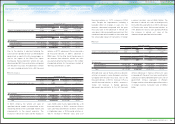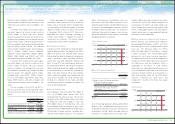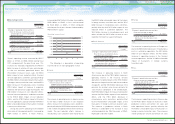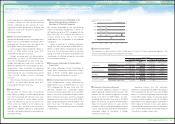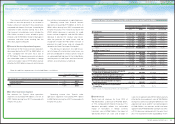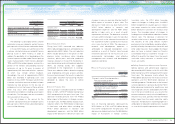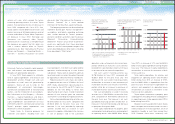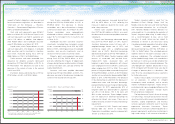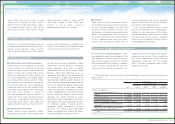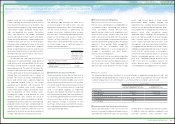Toyota 2011 Annual Report Download - page 58
Download and view the complete annual report
Please find page 58 of the 2011 Toyota annual report below. You can navigate through the pages in the report by either clicking on the pages listed below, or by using the keyword search tool below to find specific information within the annual report.
0822
Financial Section and
Investor Information
Business and
Performance Review
Special FeatureMessage/Vision
Management and
Corporate Information
Management's Discussion and Analysis of Financial Condition and Results of Operations
Of the ¥32.3 billion increase in costs related
to other recalls and safety measures taken during
fiscal 2010, approximately ¥21.0 billion is
attributable to an accrual of additional costs in
fiscal 2010 related to customer satisfaction
measures with respect to Tacoma pick-up trucks
reflecting an update to the repair ratio, based on
fiscal 2010 repair experience, and the remainder
is the result of an increased number of small-scale
recalls and other safety measures.
The following is a description of the four
recalls and other safety measures referenced
above.
In fiscal 2010, Toyota experienced a significant
increase in the number of vehicles subject to
recalls and other safety measures. There were
over 14,000 thousand vehicles worldwide subject
to recalls and other safety measures in fiscal
2010, the majority of which occurred in the third
and fourth quarters of fiscal 2010 relating to the
following four recalls and other safety measures.
In November 2009, Toyota announced a
safety campaign in North America for certain
models of Toyota and Lexus brands’ vehicles
related to floor mat entrapment of accelerator
pedals, and later expanded it to include additional
models. The vehicle models involved were Camry,
Avalon, Prius, Tacoma, Tundra, ES350, IS250/350,
Highlander, Corolla, Venza and Matrix. In addition,
in March 2011, Toyota expanded the safety
campaign coverage to include additional models
to heighten the level of reassurance for customers.
The vehicle models involved were LX570, RAV4,
and 4Runner. As of the end of March 2011,
approximately 58% of the approximately 7,600
thousand vehicles included in the campaign were
remedied to address the potential issues.
In January 2010, Toyota announced a recall
in North America for certain models of Toyota
vehicles related to sticking and slow-to-return
accelerator pedals. The vehicle models involved
were Tundra, Sequoia, Avalon, Camry, Corolla,
Matrix, RAV4 and Highlander. As of the end of
March 2011, approximately 89% of the
approximately 2,500 thousand vehicles subject to
this recall were remedied to address sticking and
slow-to-return accelerator pedals.
Also in January 2010, Toyota announced a
recall in Europe and China for certain models of
Toyota vehicles related to sticking and
slow-to-return accelerator pedals. The vehicle
models involved in Europe were Yaris, Verso,
Corolla, Auris, Aygo, RAV4, iQ and Avensis. In
China, the recall was limited to RAV4. As of the
end of March 2011, approximately 89% of the
approximately 1,700 thousand vehicles subject to
this recall in Europe, and approximately 99% of
the approximately 7,500 thousand vehicles subject
to this recall in China, were remedied to address
sticking and slow-to-return accelerator pedals.
In February 2010, Toyota announced a
worldwide recall related to the software program
that controls the anti-lock braking system (ABS) in
Prius, HS250h, Prius PHV and SAI. As of the end
of March 2011, approximately 96% of the
approximately 430 thousand units subject to this
recall received program updates.
As of the end of March 2011, a total of
approximately 12.3 million remedies were
announced on vehicles subject to the above four
recalls and other safety measures. Total estimated
costs associated with the above four recalls and
other safety measures amounted to ¥89.0 billion
for fiscal 2010. Of this amount, actual payments
incurred for fiscal 2010 amounted to ¥32.4 billion
yen. Specific types of costs involved include costs
for parts, labor and costs related to loaner vehicles.
The net changes in the accrual for the four
recalls and other safety measures described
above consist of the following:
Net revenues in Other decreased due to decreases of Toyota’s vehicle unit sales by 48 thousand
vehicles in Central and South America, 10 thousand vehicles in Oceania, and 105 thousand vehicles
in Africa compared to the prior fiscal year as a result of a downturn in the markets.
Operating costs and expenses decreased by
¥2,187.1 billion, or 10.4%, to ¥18,803.4 billion
during fiscal 2010 compared with the prior fiscal
year. This decrease resulted primarily from the
¥963.3 billion impact of fluctuations in foreign
currency translation rates, the ¥520.0 billion
impact of cost reduction efforts, the ¥470.0 billion
decrease in fixed costs, the ¥178.7 billion
decrease in research and development expenses,
and the approximately ¥110.0 billion impact of the
decrease in vehicle unit sales and the changes in
sales mix, partially offset by the ¥11.2 billion
impact on increase in parts sales. The decrease
in fixed costs and other efforts are partially offset
by the ¥105.7 billion increase in costs resulting
from a change in the estimation model of expenses
related to future recalls and other safety measures.
The ¥946.3 billion in cost reduction efforts,
decrease in fixed costs and other efforts was
partially offset by ¥97.0 billion net increase in
costs related to recalls and other safety measures
from fiscal 2009 to fiscal 2010. This net increase
includes a ¥105.7 billion increase in costs resulting
from a change in the estimation model used to
record Toyota’s liability for recalls and other safety
measures in fiscal 2010, an ¥89.0 billion increase
resulting from the total estimated costs of the four
recalls and other safety measures in fiscal 2010
as described below, and a ¥32.3 billion increase
in costs related to other recalls and safety
measures in fiscal 2010, offset by a decrease of
approximately ¥130.0 billion related to customer
satisfaction measures with respect to certain
Tacoma pick-up trucks in North America recorded
in fiscal 2009 also described below.
Operating Costs and Expenses
Yen in millions
Year ended March 31, 2010 vs. 2009 Change
2009 2010 Amount Percentage
Operating costs and expenses
Cost of products sold ¥17,468,416 ¥15,971,496 ¥(1,496,920) −8.6%
Cost of financing operations 987,384 712,301 (275,083) −27.9%
Selling, general and administrative
2,534,781 2,119,660 (415,121) −16.4%
Total ¥20,990,581 ¥18,803,457 ¥(2,187,124) −10.4%
Yen in millions
Changes in operating costs and expenses: 2010 vs. 2009 Change
Effect of decrease in vehicle unit sales and changes in sales mix ¥ (110,000)
Effect of fluctuation in foreign currency translation rates (963,300)
Effect of increase in parts sales 11,200
Effect of decrease in research and development expenses (178,700)
Effect
of cost reduction efforts, decrease in fixed costs and other efforts
(946,324)
Total ¥(2,187,124)
58TOYOTA ANNUAL REPORT 2011




